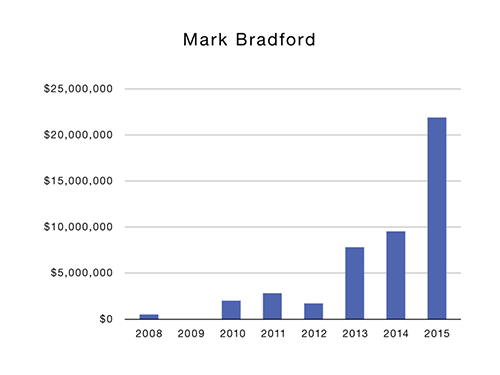Jean-Michel Basquiat. Courtesy of Sotheby’s.
Basquiat, moreover, has dominated this list for more than two decades; only in the last eight years, or since Barack Obama took office, have other African-American artists cracked the top 10. During Obama’s first term, Ligon joined Basquiat in that rarefied company; over the last four years, Bradford and Mehretu joined them.
“Basquiat is simply a great artist,” Joyner said, “and so these days you walk into Christie’s, and the Basquiat works hang next to the $40 million Richters. And that’s the way it should be.”
“For me, Basquiat is the singular artist of his generation,” Nussbaum said. “His artistic language is one that speaks to the entire global population. He speaks to collectors from every corner of the Earth. I’m not so sure every generation has these artists who transcend the period they’re working in, and he’s one of them. I expect his market will continue to grow even beyond his enormous current highs.”
Coming Back Down to Earth
While black artists appear at the top of the list in a greater proportion than their presence in the population, that figure becomes more in line with demographics as you dig deeper, surveying the top 100 artists by volume. In addition to Basquiat, Bradford, Ligon, and Mehretu, several other art stars appear, for 11 black artists among the top 100: Kara Walker, Rashid Johnson, Ellen Gallagher, Kehinde Wiley, Mickalene Thomas, Theaster Gates, and Nick Cave. Another key market metric tells a similar story: of the contemporary American artists selling for over a million dollars at auction, one-tenth are black.
Looking worldwide, by contrast, it’s worth noting that among the top 100 artworks by price sold at auction in the last five years, there’s exactly one black artist, and he appears as number 100: David Hammons, one of whose works sold at auction at Phillips New York in 2013 for $8 million. Among the top global living artists by volume, meanwhile, Bradford, Ligon, Hammons, and Mehretu all appear in the top 100.
If she’s elected, will Hillary Clinton’s presidency similarly coincide with women artists ascending into the top echelons of the art market? We’ll all be watching on November 8.
Research by Fabian Bocart for artnet Analytics.
Follow artnet News on Facebook.
https://news.artnet.com/market/racial-bias-art-auction-market-672518





